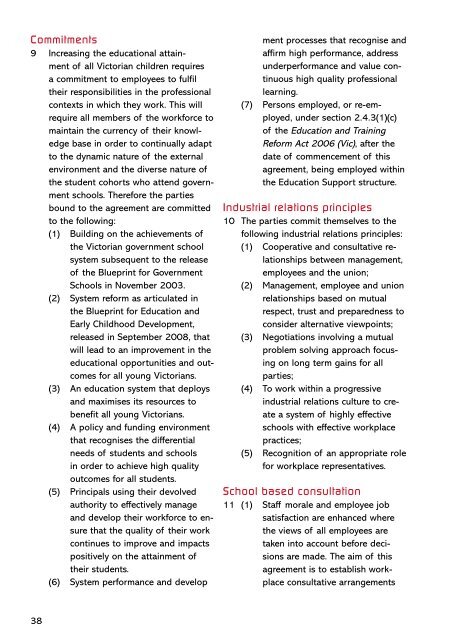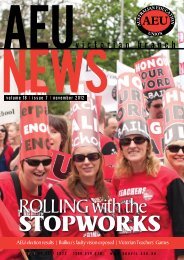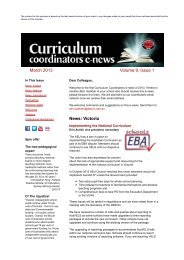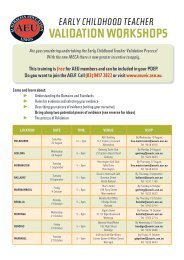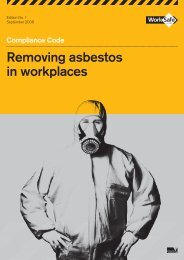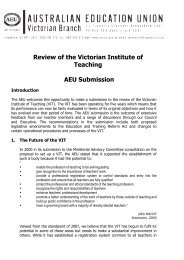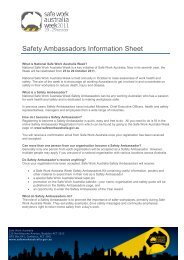implementation guide - Australian Education Union, Victorian Branch
implementation guide - Australian Education Union, Victorian Branch
implementation guide - Australian Education Union, Victorian Branch
You also want an ePaper? Increase the reach of your titles
YUMPU automatically turns print PDFs into web optimized ePapers that Google loves.
Commitments9 Increasing the educational attainmentof all <strong>Victorian</strong> children requiresa commitment to employees to fulfiltheir responsibilities in the professionalcontexts in which they work. This willrequire all members of the workforce tomaintain the currency of their knowledgebase in order to continually adaptto the dynamic nature of the externalenvironment and the diverse nature ofthe student cohorts who attend governmentschools. Therefore the partiesbound to the agreement are committedto the following:(1) Building on the achievements ofthe <strong>Victorian</strong> government schoolsystem subsequent to the releaseof the Blueprint for GovernmentSchools in November 2003.(2) System reform as articulated inthe Blueprint for <strong>Education</strong> andEarly Childhood Development,released in September 2008, thatwill lead to an improvement in theeducational opportunities and outcomesfor all young <strong>Victorian</strong>s.(3) An education system that deploysand maximises its resources tobenefit all young <strong>Victorian</strong>s.(4) A policy and funding environmentthat recognises the differentialneeds of students and schoolsin order to achieve high qualityoutcomes for all students.(5) Principals using their devolvedauthority to effectively manageand develop their workforce to ensurethat the quality of their workcontinues to improve and impactspositively on the attainment oftheir students.(6) System performance and development processes that recognise andaffirm high performance, addressunderperformance and value continuoushigh quality professionallearning.(7) Persons employed, or re-employed,under section 2.4.3(1)(c)of the <strong>Education</strong> and TrainingReform Act 2006 (Vic), after thedate of commencement of thisagreement, being employed withinthe <strong>Education</strong> Support structure.Industrial relations principles10 The parties commit themselves to thefollowing industrial relations principles:(1) Cooperative and consultative relationshipsbetween management,employees and the union;(2) Management, employee and unionrelationships based on mutualrespect, trust and preparedness toconsider alternative viewpoints;(3) Negotiations involving a mutualproblem solving approach focusingon long term gains for allparties;(4) To work within a progressiveindustrial relations culture to createa system of highly effectiveschools with effective workplacepractices;(5) Recognition of an appropriate rolefor workplace representatives.School based consultation11 (1) Staff morale and employee jobsatisfaction are enhanced wherethe views of all employees aretaken into account before decisionsare made. The aim of thisagreement is to establish workplaceconsultative arrangementsthat ensure the Employer’s responsibilityto make school based decisionsis carried out in a frameworkthat enables staff to have inputinto the decisions that affect theirworking life.(2) The principal, as the Employer’srepresentative, has ultimateadministrative and operationalresponsibility for decisions at theschool level, provided that thesedecisions are made in accordancewith the consultation principlesoutlined below.(3) For the purpose of this clause theparties adopt the following commentsmade by Smith C. in CPSU,the Community and Public Sector<strong>Union</strong> v Vodafone Network Pty Ltd(Print PR911257):“Consultation is not perfunctoryadvice on what is about to happen.This is common misconception.Consultation is providingthe individual, or other relevantpersons, with a bona fide opportunityto influence the decisionmaker… Consultation is notjoint decision-making or even anegative or frustrating barrier tothe prerogative of managementto make decisions. Consultationallows the decision making processto be informed, particularlyas it may affect the employmentprospects of individuals.”(4) The consultative arrangementsmust allow for the direct inputof staff and the union/s at theschool.(5) (a) (i) The principal, as theEmployer’s representative,must put in place formalstaff consultation structures,that ensure schoolstaff and the union at theschool have the choice andopportunity to be involvedin the consultation processin the school. The consultativestructures, includingthe operational procedures,must be agreed at theschool level no later than1 September and may befor one or more years tocommence from term 4.(ii) The importance of workplacerepresentatives beingprovided with the opportunityand time to canvassthe views of staff toensure informed consultationcan occur on mattersset out in subclauses (6)and (7) is recognised. Tothis end the consultativeprocedures must includearrangements that enablethis to occur within theschool.(b) Each school shall report to theEmployer whether consultationarrangements have beenagreed under subclause (a).(c) Where a school reports thatconsultative arrangementshave not been agreed thematter shall be considered bya nominee of the Employerand a nominee of each unionwho shall discuss the matterand determine whether, inthe particular circumstances,agreed arrangements can beimplemented or the arrange-38 39


